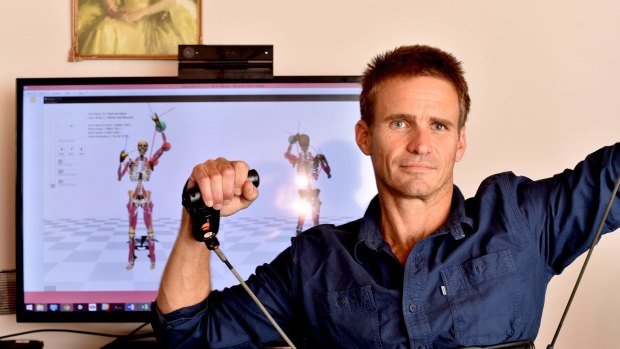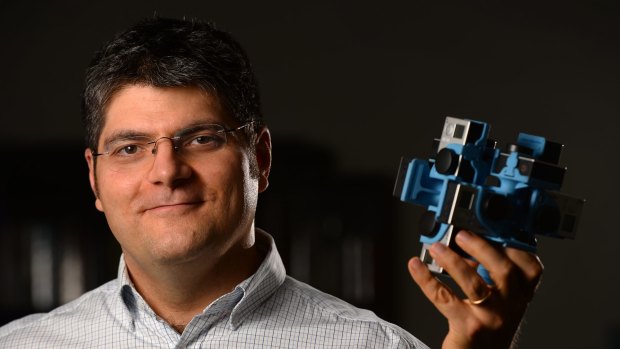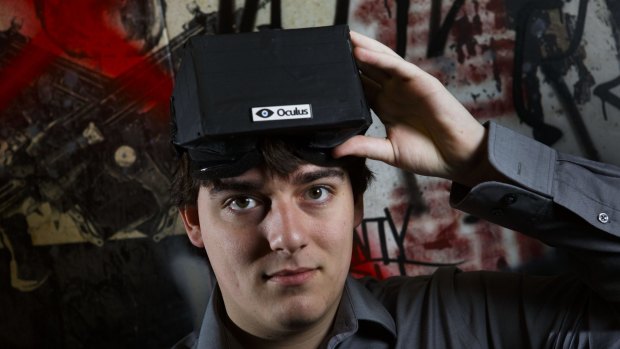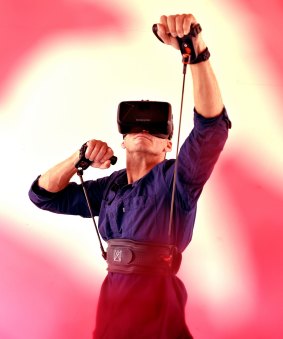This was published 9 years ago
Forget jet-packs, virtual reality is technology's next big thing and it's here already
From exercise to travel to workplace inductions, virtual reality devices are likely to change our world views, without anyone leaving the house, writes Andrew Masterson.
By Andrew Masterson
Forget jet-packs. As any serious geek will testify, today's technological Next Big Thing is consumer virtual reality, or VR.
The manufacture of VR headsets, along with the devices that deliver content to them, is easily the largest and bloodiest of the current global commercial electronics battlefields. Billions of dollars are being invested in research, development and marketing. Big names, from Mark Zuckerberg to Beyonce, are being invoked.
And in the midst of all this corporate Sturm und Drang, two tiny Australian companies, in Ballarat and Bondi, are about to reap the whirlwind.
"It's like there's gasoline everywhere," said Stefan Pernar, 39, of Ballarat tech start-up Virtual Reality Ventures. "Now people are bringing in the matches. I'm moving in spheres today that I wouldn't have dared to even dream of a year ago."

Matt Long with the virtual resistance handsets used to measure your force that has applications in gaming and health and fitness.Credit: Steven Siewert
The term "virtual reality" broadly describes an audio-visual experience that is completely immersive: the user is inside an apparent three-dimensional, 360-degree world. Unlike two-dimensional screen-based audio-visual material, you cannot look away. There is no "away".
The technology - variously clunky or requiring physically massive hardware - has been around since the 1950s. Over the years it has inspired novelists such as William Gibson, and films such as Tron: Legacy and Spy Kids: Game Over. The long-running British television comedy Red Dwarf featured an immersive game called Better Than Life.
However, it was not until 2012 that economics and engineering combined to make household VR sets an affordable reality. The fuse for the current explosion was lit that year when a young United States developer called Palmer Luckey literally gaffer-taped together a prototype headset that he called the Oculus Rift. The headset was not only lightweight and snug, it also interfaced easily with a laptop computer, opening up a potentially endless stream of content.
In March 2014 - just 12 months ago - Facebook bought the rights to the product for a staggering $US2 billion.

Stefan Pernar, Managing Director of Virtual Reality Ventures.Credit: Adam Trafford
Boom! Since then Korean electronics giant Samsung has launched its own headset, the Gear VR, and configured its latest smartphones to handle VR content. Rival company HTC announced its headset just this week. Google released a cardboard headset to encourage content developers. Apple - potentially the 800-kilogram gorilla in the corner - quietly patented a VR headset in February this year, but is yet to signal its intentions.
The immediate focus of all this activity is gaming, but the really big prizes - and the really massive roll-outs - lie in more quotidian deployments. Stefan Pernar in Ballarat is targeting tourism, sport, real estate and business. Over in Bondi, Matt Long, co-founder of a tiny start-up called Realm, has his eyes on healthcare and fitness.

Palmer Luckey, the creator of the Oculus Rift virtual reality gaming headset. Facebook announced on March 26, 2014, that it was buying Oculus for $2 billion, signaling its belief in virtual reality as an essential platform for future growth. Credit: Patrick T. Fallon
And, at least at this admittedly early stage, indications are they are both bang on the money.
"It's quite serendipitous that our system is ready to commercialise now," said Long, 42, who with a couple of co-workers operates out of a hastily repurposed garage. "The cosmos has come together and the timing is right."

Matt Long and his colleagues are aiming at the gaming world for their first commercial developments. Credit: Steven Siewert
Long's Realm system solves a problem that has for ages plagued virtual reality: users can look, but they can't touch. VR structures are ethereal. The Realm system comprises hand-pieces that link to a belt and then to a VR headset and provide, via a rather clever algorithm, a sense of force and resistance in happy agreement with Newton's Third Law of Motion.
Using the Realm gear, you can adjust the level of force applied to any given task, such as swinging a bat, to lob the target ball a little way or thump it out of the park. The virtual force applied provokes an equal and opposite real-word reaction. It requires energy to resist such force: do it enough times and, just like in a real game, your muscles will start to tire.
"For the first time ever, you can factor force and resistance into screen-based apps," explained Long, a former filmmaker. "You can have everything that you can experience in a real-world physical encounter."
Long and his colleagues are aiming at the gaming world for their first commercial developments. They are currently exhibiting at the massive annual Game Developers' Conference in San Francisco, but their eventual goal is the healthcare industry.
Realm's technology was developed by a research team at Teesside University in Britain. One of the original inventors, sport scientist Dr Pierre Lagadec, moved to Sydney and teamed up with Long.
"There was a danger that the system could have stayed in the university's research-and-development department for years," explained Long.
"Its original purpose was an intervention system in biomechanics. Set at a high enough resistance, the system can be used by people for exercise regimes to attack obesity, cardio-vascular disease, and diabetes. That's where I think it's got its greatest social potential."
At first blush, Realm's exercise potential seems merely to duplicate what anyone can do in the physical world, without fancy electronics. However, a VR resistance-enabled regime could work well in settings such as rehabilitation wards where space is limited, or for people uncomfortable with being seen exercising in public. It will also be good for keeping patients interested: in a Realm VR environment you can have as many barbells, tennis racquets, nunchucks, samurai swords and boxing gloves as you wish, without the need to wedge them in the cupboard when you've finished.
Globally, the medical and healthcare industries have been quick to grasp the potential of VR applications. Using virtual reality to train surgeons is now commonplace (because it's better to stuff up a virtual gall bladder operation than a real one), and work is under way on surgery-at-a-distance systems, where a surgeon in one location immerses in a VR live-stream to manipulate a robotic arm operating on a patient in a second location. Being able to have the sensation of tissue resistance and how much force to apply makes both these surgical applications more viable.
Last year, Stanford University and the University of Washington launched VR programs designed to distract young patients undergoing painful wound-care procedures. (picture below is courtesty of University of Washington)
They involve popping balloons and throwing snowballs. The distraction potential would rise significantly if the balloons resisted the virtual pin, or the snowballs had weight.
This ability to distract users - to completely immerse them in a made-up world that contains not a trace of the real one - is the appeal of virtual reality.
"The hardest part for us is to just get five minutes with somebody for them to try it," said Stefan Pernar at Virtual Reality Ventures. "After that, everything is different."
His observation is accurate, for the very simple reason that it is impossible to imagine a virtual reality environment before actually experiencing one. Watching VR-themed movies such as The Matrix or The Lawnmower Man, despite the snazzy special effects, remains a defiantly two-dimensional, discrete experience.
This reporter tried VR, in Pernar's office in the Ballarat technology park, a refurbished 19th century building on the Federation University campus. Seated on a swivel chair, Samsung Gear VR mask on (with a Samsung Note 4 phone strapped inside it), I moved around at will inside an enormous virtual empty warehouse. Navigation was by head-turning - look at something, float towards it, look away, turn around, move in the opposite direction. The building towered above me, and stretched away into shadowy distances.
I could feel myself putting my arms out to keep from colliding with the walls, reflexes easily overriding the bit of my brain that knew damn well I was seated in the real world. I looked down at the virtual floor, and immediately felt extremely dizzy and nauseous.
"That effect is caused 'vection'," explained Pernar. "It's a pretty common effect, and the mechanics of how it happens haven't been fully understood yet. It's a new medium and no one has all the answers. VR is the wild west."
Vection, or cyber-sickness, is a stubborn issue for the burgeoning VR industry, not least because throwing up while wearing a headset that blinds you to the real world must be distinctly unpleasant. Researchers as diverse as optometrists in NSW and engineers in Brazil are working on the problem. Pernar has no doubt it will soon be solved.
His own entry into VR was rapid and surprising. A few years ago, he was based in China as head of corporate security for multinational tech giant Siemens. Seeking a tree-change, he moved to Australia, bought a bush-block in central Victoria, and established his virtual reality start-up. That was just two months before Zuckerberg bought Oculus Rift and the boom began.
Barely 12 months later, Pernar was approached by Samsung. Today, his is the only VR company in the world formally partnered up with the South Korean giant. He has just five employees and happily admits that the immediate future looks "daunting".
Pernar's vision is to use virtual reality for essentially business purposes. "Construction, retail, tourism, sport, entertainment and real estate are all industries we are looking at," he said. "The adult entertainment and arts industries are also in the market, but we're not working in those areas."
Even allowing for hype, cheap and abundant virtual reality has the potential to revolutionise many industries. In real estate, virtual reality tours of houses on the market are easy to imagine, for instance. Pernar notes that there is considerable interest from large companies in using VR to induct new employees, allowing them to see around the workplace without getting in the way. Power company AGL started using Samsung VR as an employee training aid this month.
Tourism is also a hot-button potential VR market. Imagine being able to wander around Disney World before deciding whether to invest thousands in airfares. Pernar sees this as a big area.
Interestingly, Matt Long at Realm does as well, but from a different perspective. "Every year thousands of people get on planes and fly off to Egypt to walk around the pyramids," he said. "You have to wonder if that's a truly sustainable thing to do over time. Maybe we could visit the pyramids through VR one day."
Companies such as the Marriott Hotel Group and the British Columbia tourist bureau are already producing virtual reality previews of their destinations. As image quality - already high - improves, Long's idea of the virtual visit actually substituting for a real one might not be too wide of the mark.
Back in Ballarat, Stefan Pernar is preparing to gear up his business by a couple of orders of magnitude. Away from the gamer-centred developments that grab all the headlines, his business-focused approach has met with significant and sudden demand.
There are matters of commercial confidentiality involved that preclude naming names, but in recent weeks his little start-up has been approached by a major sporting organisation wanting to explore the potential for live-streaming events in virtual reality. Other very large corporations now in discussions include at least one airline, a telecommunications behemoth, and television content-delivery operators.
"Virtual reality is one of those really science-fiction things that is actually coming true, right at this moment," said Pernar.
And how. In an estimate generally regarded as conservative, Facebook recently predicted sales of up to 100 million Oculus Rift sets by 2024. There are already more than 500 games, movies, trailers or demonstration programs available for the Oculus system - a number that seems likely to grow exponentially. In February, Facebook's chief product officer Chris Cox flagged the intention to enable users to generate their own VR content to share on the platform.
Cox hinted that Beyonce was already preparing to post some, although she hasn't actually done so yet. Quite possibly, she's still trying to get her head around the idea. Many people are.
"There's a lot still to be worked out," said Pernar. "VR represents a whole new way of storytelling. You become the main actor in that experience - it becomes 'I am' rather than 'I see'. None of the restraints of time and space that exist in film and television exist in virtual reality.
"But this also brings significant challenges in content creation. Because it's fully immersive, you have to use 3D scanners, make 360-degree video, and use 3D modelling when you're stitching it together. Playback also has challenges - how do you not make people feel sick when they're inside?"
In one sense these are all teething problems. Oculus Rift, Samsung Gear, HTC's new headset and the others that are still to be launched are only on the verge of mass-scale shipping. As technologies from television to computers to PlayStations demonstrated, big numbers induce mongrel vigour and emergent properties.
"It's important to remember that virtual reality right now is as bad as it's ever going to get," said Pernar. "It will only get better from here."
In Ballarat and Bondi right now, timing and technology have fortuitously combined to offer Australian developers significant roles in a technological surge largely dominated by the United States and Korea. Perhaps, at least in part, we might be the clever country, after all.
"You just want to tell everybody how cool this technology is," said Pernar. "And then, when they try it, they also become evangelists and want to tell others the same thing."